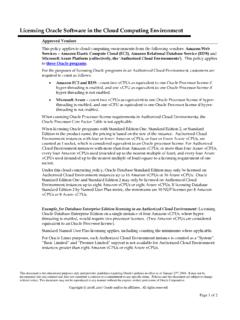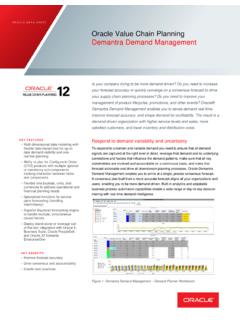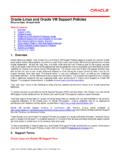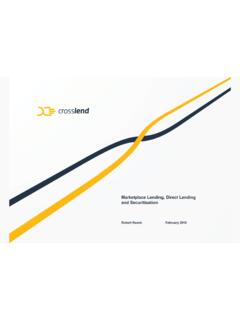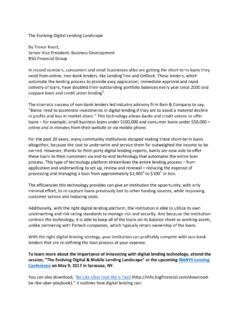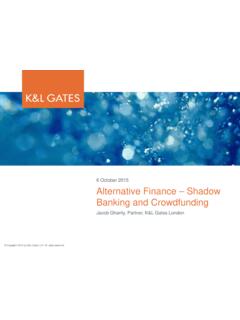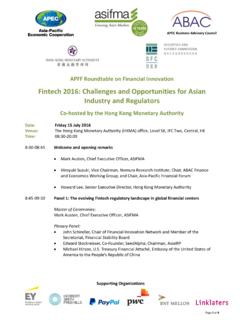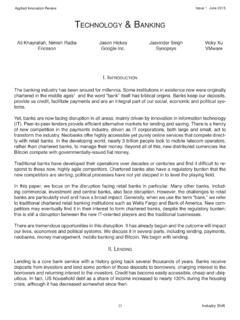Transcription of Digital transformation: The challenges and …
1 Digital transformation The challenges and opportunities facing banks February 2016 WHITE PAPER 2 Digital transformation Contents Executive Digital The role of Four key Digital 1) Launching a Digital brand ..11 2) Digitising 3) Modernising the Digital experience ..17 4) Launching a new Digital Conclusion ..28 3 Executive summary This white paper has been produced from three interactive webinars or think tanks hosted by Efma and with presentations from the Oracle Financial Services Global Business Unit. The two main speakers were Aubrey Hawes, Senior Director, Digital Experience and Tushar Chitra, Senior Director, Digital Engagement. The paper also includes the thoughts and comments made by the webinar participants. In recent years, Oracle has been observing and has been involved in the Digital transformation initiatives that are taking place in the fnancial services sector and has seen some effective strategies being implemented by banks.
2 However, there are still many challenges and opportunities ahead and the webinar discussions helped to highlight some of these. The frst session focused on Digital disruption, including the industries it is affecting; the speed at which is happening; the time taken to adopt new technologies; and the impact on the fnancial services sector. It then explored the potential role of fntechs and whether they should be considered as partners or competitors. Finally, the webinar discussed the implications of deploying four different Digital strategies as the foundation for Digital transformation : launching a Digital brand; digitising processes; modernising the Digital experience; and launching a new Digital capability. The second think tank looked at the four Ps of Digital transformation Product, People, Price and Place ( experience). This session focused mainly on the frst three of these, particularly in relation to Digital processes.
3 It tried to defne what a Digital process is and the boundaries that surround the process, and examined how it can be made more customer-centric. The delegates gave some examples of Digital processes and also briefy discussed pricing issues and product manufacturing. The fnal session focused on the Place and looked in some depth at how the Digital experience is redefning interactions between banks and their customers. It included discussions on new technologies such as Digital wallets and also the importance of data. We hope you enjoy reading this white paper and that you fnd it informative, stimulating and challenging. Banks need to be fully prepared for the Digital future that lies ahead but we believe that with the right strategies and the right mindset, they can turn these challenges into exciting opportunities . Vincent Bastid Chief Executive Offcer, Efma Aubrey Hawes Senior Director, Digital Experience, Oracle Financial Services Global Business Unit Tushar Chitra Senior Director, Digital Engagement, Oracle Financial Services Global Business Unit 4 Digital transformation Digital disruption A brief history Waves upon waves of Digital disruption Digital disruption isn t an isolated event but is something that has repeatedly happened over the last three decades, with different waves occurring across different types of industry segments.
4 Initially, in the 1990s, sectors such as music, photography and video were all disrupted by new entrants and new players who were embracing Digital technology. In the 2000s, a new set of industries started to be disrupted by the Digital revolution, such as TV, travel and recruitment. For instance, with the advent of YouTube, people started to deliver their own content. In the travel industry, people started to book their own holidays using the Internet. In recruitment, companies started to leverage social media, with tools such as online job boards. The 2010s are now experiencing a third wave of Digital disruption. Areas such as retailing which frst experienced disruption in the 1990s are now seeing further changes. This time, one of the key drivers is the way in which customers interact with brands. Digital marketing is very different from traditional methods, due largely to the advent of social media.
5 As a result, it has started to transform many different industries, such as the automotive sector. In this sector, people no longer tend to visit car dealers as the frst stage of looking for a car: they now usually conduct all of their research online and then go to the saleroom to make the fnal purchase. Finance and healthcare are the next industries that are going to change as part of this ongoing disruption. 5 Financial impact of disruption When industry sectors have been through a phase of disruption, the effects have been quite interesting. The diagram above gives examples of four different sectors that have been affected. When disruption starts to occur, it s not only the role of the established players that changes there s also quite a large fnancial impact on that specifc market as well. A clear example can be seen in the music industry, where the global market now is only worth about half of its value in 2000.
6 An even more dramatic impact has occurred with NASDAQ, which went through decimalisation, when the stock market had to convert from fractions to decimals. The trading foor revenues are now roughly a third of what they once were. The newspaper print advert market has also been hugely affected and is about a third of what it was. If Digital is added into that equation, it climbs back to a market of about $20 billion but it s still appreciably lower than before: once the market has been disrupted, it changes signifcantly. The other interesting sector is retailing: e-commerce was fairly insignifcant in 2000. It still isn t a large section of the market (less than 6%) but all of this growth is coming as a result of the disruption. 6 Digital transformation Digital is better, stronger and faster So, different industries have been disrupted and this has had a fnancial impact on them.
7 But why is disruption happening more quickly and more widely than it did 20 or 30 years ago? The graphic above from Forrester shows that in the old world of disruption, it was very expensive to go back and try and disrupt the market. As a result, very few people were doing it. However, in today s world, with the advent of Digital disruption, developments such as big data and the cloud are drastically reducing the cost associated with Digital disruption, with the result that many more people are involved in it. It s therefore having a much wider impact on the market. The consequence is a rapid pace of change. The right hand side of the graphic above shows what was happening in just one minute on the Internet between 2012 and 2014. One interesting fact is that in 2012, Instagram was still an infnitesimally small service. Even looking at just the expansive growth in mature solutions such as Google and Facebook, there has been mass adoption in the past two years.
8 The impact of Digital disruption can be far-reaching. For instance, some years ago, Blockbuster had a chance to buy Netfix but turned it down, as it wasn t seen as a competitive threat. As a result, it missed a vital opportunity. As more industries felt the impact of Digital disruption, Blockbuster s fortunes waned. It s vital, therefore, that the importance of Digital disruption isn t overlooked and the need to respond and take action is essential. 7 Pace of change is only getting faster Indeed, the pace of change caused by Digital disruption is still continuing to increase. In Brett King s book, Banking , he chooses a level of 50 million users as the defnition of a target fgure for a market. For planes and cars to reach this level took over 60 years. Credit cards took 28 years but more recently, contactless credit cards took only four years to reach 50 million users.
9 So, the pace of change is getting much faster and the fnancial services industry has to adapt if banks are to succeed and survive. 8 Digital transformation The role of fntechs State of fntech Funding is booming: almost $14B in the last 12 months from less than $1B in Q2 2010 to $3B in Q1 2015 Fintech companies are currently very active at trying to disrupt the fnancial services market. There is a huge funding boom happening in fnancial services, similar to the one that happened in the 2000s, when the Internet was starting to take off and there was a lot of money chasing a lot of different ideas. Fintechs today primarily sit across three segments of the fnancial services industry: payments, lending and personal fnance. There are also many sub-segments within these. There are two main reasons why these are the primary segments that the fntechs are pursuing: They are areas with signifcant fees and that also have a strong push towards a Digital interaction.
10 The top ten privately funded fntechs represent almost US$50 billion in market cap. Meanwhile, there are over 1,200 fntechs that are being tracked by Venture Scanner across 18 different segments. Fintechs want to be able to work cheaper, faster and clearer and to provide a better transparency of what s happening. They re often trying to kill banks by going after different niches. Partners or competitors? As a result, some banks believe that fntechs are competitors that will ultimately take a large slice of the fnancial services cake These banks feel that customers might prefer the solutions provided by fntechs because they are able to move more rapidly than banks can at the moment. As a result, banks could lose the customer relationship on the Internet to the fntechs. However, in the medium term, customers will want to keep their accounts with a bank because trust is a very important issue to them.
